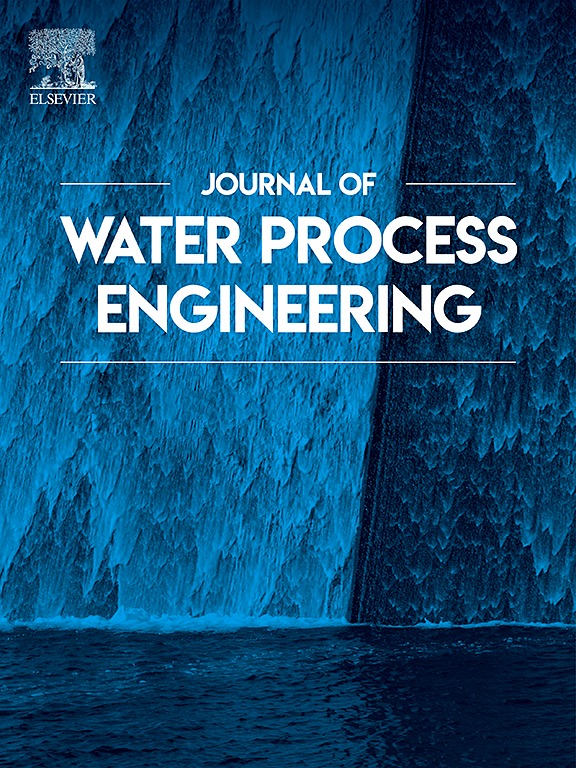Recycling in livestock: Reuse of corral washing water and reduction of the release of pathogenic microorganisms into the environment
IF 6.3
2区 工程技术
Q1 ENGINEERING, CHEMICAL
引用次数: 0
Abstract
This study aimed to assess the viability of utilizing dairy cattle wastewater (DCW) in a recirculation system for cleaning cattle confinement units. Aligned with the United Nations Sustainable Development Goals, particularly “SDG 6: Clean Water and Sanitation”; “SDG 12: Responsible Consumption and Production” and “SDG 14: Life Bellow Water”, the objectives included quantifying water savings achieved through recirculation, and determining the reduction in enterobacteria, indicative of Escherichia coli, prevented from entering the environment. The recirculation of DCW for hydraulic cleaning of cattle confinement unit floors resulted in remarkable water savings, reaching up to 99.61 %. This process successfully averted the release of approximately 6.43 × 104 CFU/mL of pathogenic organisms into the environment. The incorporation of a biodigester into the system yielded dual benefits in the form of biogas and biofertilizer, which could be reintegrated into the production process. Beyond the immediate benefits of water conservation, this approach contributes to sustainable water resource management and preserves the quality of watercourses. The integration of such innovative practices underscores the potential to enhance environmental stewardship in agriculture, aligning with broader goals of sustainability and circular economic principles.

牲畜循环利用:畜栏洗涤水的再利用和减少病原微生物向环境中的释放
本研究旨在评估在循环系统中利用奶牛废水(DCW)清洁牛禁闭单元的可行性。符合联合国可持续发展目标,特别是“可持续发展目标6:清洁水和卫生设施”;“可持续发展目标12:负责任的消费和生产”和“可持续发展目标14:水下的生命”,目标包括量化通过再循环实现的节水,并确定防止进入环境的肠杆菌(表明大肠杆菌)的减少。将DCW再循环用于牛栏地板的水力清洗,节水效果显著,节水率高达99.61%。这一过程成功地避免了大约6.43 × 104 CFU/mL的致病生物释放到环境中。在系统中加入生物消化器产生了沼气和生物肥料的双重效益,可以重新整合到生产过程中。除了节约用水的直接好处之外,这种办法还有助于可持续的水资源管理和保持水道的质量。这些创新做法的整合凸显了加强农业环境管理的潜力,与可持续性和循环经济原则的更广泛目标保持一致。
本文章由计算机程序翻译,如有差异,请以英文原文为准。
求助全文
约1分钟内获得全文
求助全文
来源期刊

Journal of water process engineering
Biochemistry, Genetics and Molecular Biology-Biotechnology
CiteScore
10.70
自引率
8.60%
发文量
846
审稿时长
24 days
期刊介绍:
The Journal of Water Process Engineering aims to publish refereed, high-quality research papers with significant novelty and impact in all areas of the engineering of water and wastewater processing . Papers on advanced and novel treatment processes and technologies are particularly welcome. The Journal considers papers in areas such as nanotechnology and biotechnology applications in water, novel oxidation and separation processes, membrane processes (except those for desalination) , catalytic processes for the removal of water contaminants, sustainable processes, water reuse and recycling, water use and wastewater minimization, integrated/hybrid technology, process modeling of water treatment and novel treatment processes. Submissions on the subject of adsorbents, including standard measurements of adsorption kinetics and equilibrium will only be considered if there is a genuine case for novelty and contribution, for example highly novel, sustainable adsorbents and their use: papers on activated carbon-type materials derived from natural matter, or surfactant-modified clays and related minerals, would not fulfil this criterion. The Journal particularly welcomes contributions involving environmentally, economically and socially sustainable technology for water treatment, including those which are energy-efficient, with minimal or no chemical consumption, and capable of water recycling and reuse that minimizes the direct disposal of wastewater to the aquatic environment. Papers that describe novel ideas for solving issues related to water quality and availability are also welcome, as are those that show the transfer of techniques from other disciplines. The Journal will consider papers dealing with processes for various water matrices including drinking water (except desalination), domestic, urban and industrial wastewaters, in addition to their residues. It is expected that the journal will be of particular relevance to chemical and process engineers working in the field. The Journal welcomes Full Text papers, Short Communications, State-of-the-Art Reviews and Letters to Editors and Case Studies
 求助内容:
求助内容: 应助结果提醒方式:
应助结果提醒方式:


